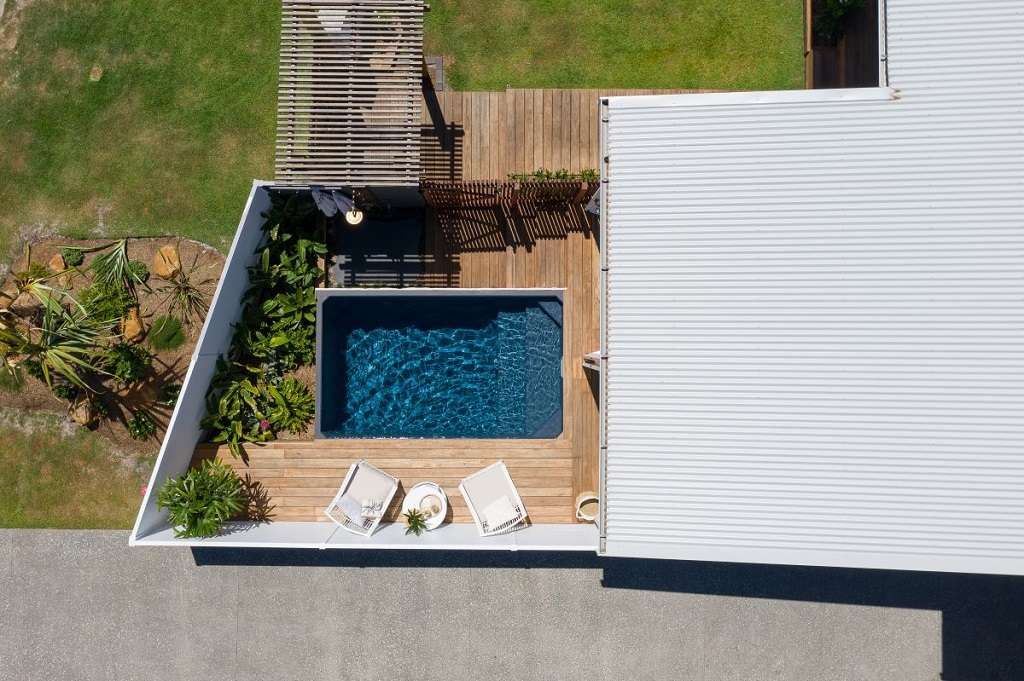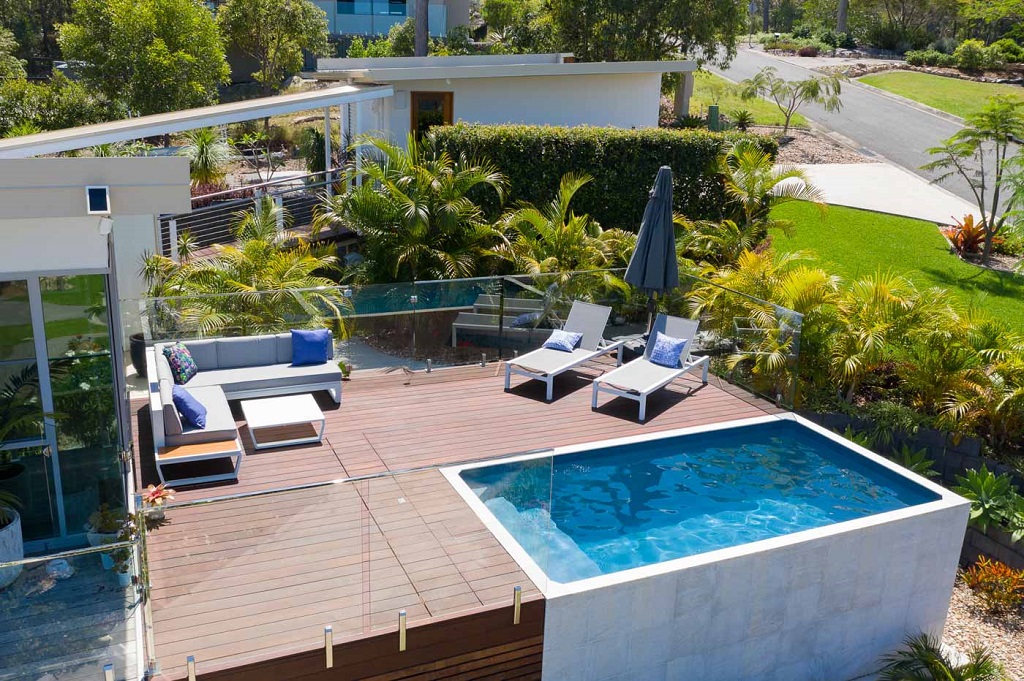Are Plunge Pools Safe?

Plunge pools, known as cold plunge pools or ice baths, have become increasingly popular. As the name suggests, a plunge pool is a small, deep pool filled with icy water that people voluntarily “plunge” into for short periods. Proponents of cold water immersion claim it provides numerous health and fitness benefits, from reducing inflammation and sore muscles to boosting mood and mental clarity. However, there are also safety considerations when using a plunge pool. In this article, we’ll take a comprehensive look at plunge pool safety.
What is a Plunge Pool?

A plunge pool is small, usually no more than chest deep, filled with icy water. While sizes and shapes vary, most are roughly 5 to 10 feet wide and 3 to 6 feet long. The water temperature is maintained between 50 and 60°F. For perspective, this is similar to the temperature of the ocean along the California coast in winter!
Plunge pools can be permanent backyard installations made of concrete, fiberglass, or vinyl liner. Portable plastic plunge pools are also available. Both permanent and mobile versions often incorporate stairs for easy entry and exit. The primary purpose is to immerse your body in the cold water for a short period, typically 1 to 3 minutes. This stimulates the body’s cold shock response.
The Theory Behind Plunge Pools
Supporters of cold water immersion claim there are numerous benefits to shocking your body with extreme cold. These purported benefits include:
- Reduced inflammation and soreness – The cold causes vasoconstriction, reducing blood flow to extremities and muscles. This may help flush waste products like lactic acid that contribute to post-workout muscle soreness. The cold may also temporarily reduce inflammation.
- Increased circulation – After exiting the cold water, vasodilation widens blood vessels, which boosts circulation. This helps deliver oxygen and nutrients throughout the body to aid recovery.
- Improved mood – The release of feel-good endorphins after cold water exposure can boost mood and mental outlook. The cold may also sharpen mental focus and clarity.
- Fat loss – Cooling the body activates brown adipose tissue, which may increase fat metabolism. However, more research is needed to substantiate this.
- Strengthened immune system – Brief cold exposure triggers anti-inflammatory responses that may boost immunity. Cold water swimming advocates claim it reduces sickness.
While these benefits seem plausible theoretically, scientific research on cold water immersion is still ongoing. More high-quality studies are needed to validate these claims fully. Regardless, many athletes, biohackers, and health enthusiasts swear by the benefits of brief, cold plunges.
Is it Safe to Use a Plunge Pool?

Despite potential benefits, icy cold water immersion also has inherent dangers that must be considered. As with any extreme practice, there are right and wrong ways to safely use a cold plunge pool. It’s essential to prioritize safety to prevent hypothermia, shock, or cardiovascular strain. When contemplating the installation of a cold plunge pool, individuals often inquire about the plungie pool cost installed recognizing that investing in quality equipment and professional installation is crucial.
Proper supervision, gradual exposure to cold water, and knowing one’s health limitations are integral to a responsible approach to cold water immersion. Always consult a healthcare professional before incorporating such practices into your routine, especially if you have pre-existing health conditions.
1. Hypothermia
Perhaps the most significant risk of cold water immersion is hypothermia – a dangerous drop in core body temperature below 95°F. It occurs when more heat is lost than the body can generate, causing vital organs to shut down. Hypothermia can set in rapidly in icy water. Death can occur once the core temperature drops below 86°F.
Limiting time spent in a plunge pool to short durations of 1-3 minutes is crucial to avoid hypothermia. Get out immediately if you feel dizzy, weak, or confused – signs of impending hypothermia. Having assistance nearby is recommended when using a plunge pool. Do not use alcohol prior, as it accelerates heat loss. Those with heart conditions or pregnant women should avoid cold plunges altogether due to hypothermia risks.
2. Shock
Sudden cold water immersion triggers an involuntary bodily response called cold shock – uncontrolled gasping, hyperventilation, and increased heart rate and blood pressure. This is a built-in survival mechanism. However, it does come with risks for those with existing health conditions.
People with heart problems are susceptible to cardiac arrest from cold shock. People living with Asthma may experience breathing difficulty. Cold shock may also cause fainting or drowning for some. Using proper plunge pool form by entering slowly and maintaining control of breathing can help reduce the risk of shock. Never plunge in alone – have someone present in case issues arise.
3. Injury
Like any pool, slip and fall risks exist with plunge pools. Entry and exit areas should have slip-resistant surfaces and grab bars. Proper water treatment and cleaning are vital to prevent slippery algae buildup on surfaces. Ensure good lighting, especially for night plunging. Plunge when sober and rested – never when exhausted or intoxicated. Avoid diving in head-first, given the shallow depth. Signage with safety rules is also recommended.
4. Gasping Reflex
Sudden submersion in cold water triggers an involuntary gasping reflex before intentional breath control kicks in. This reflexive inhaling underwater can cause accidental drowning, especially for weakened swimmers. Using proper form by crouching to shoulder level before immersion can reduce this risk. Again, never plunge alone.
5. Allergic Reactions
As with any pool, properly balanced water chemistry is essential in a plunge pool to prevent skin or respiratory irritation. Ensure proper filtration, chlorine or bromine levels, pH, and shock treatment. Consider hypoallergenic salts instead of harsh chlorine. Also, keep the pool from contaminants like dirt, leaves, and algae.
6. Blood Pressure Changes
The cold shock of immersion rapidly increases blood pressure. Those with existing high blood pressure or heart conditions could experience adverse effects from this spike. Check with a doctor before cold water plunging if you have hypertension or heart disease. Exiting slowly and maintaining slow breathing helps minimize blood pressure swings.
7. Panic Attacks
For some, the intense cold triggers panic, anxiety, or feelings of being trapped. This is understandable, given the body’s extreme cold shock reaction. Those prone to panic attacks or claustrophobia may want to reconsider using a plunge pool or work up to it gradually using coping strategies. Never force yourself to stay immersed if feeling panicked – exit immediately.
Best Practices for Plunge Pool Safety

While chilling, a plunge pool certainly comes with risks if misused. However, by following specific safety best practices, you can reap the benefits while minimizing the potential downsides:
- Start conservatively – If new to cold immersion, start with cold showers working towards plunge pools. Begin with very short 15-30 second plunges before increasing duration later. Always listen to your body.
- Check with your doctor – Ensure you don’t have underlying heart disease, hypertension, Asthma, or other conditions that could increase plunge pool risks.
- Never plunge impaired – Avoid alcohol or recreational drugs before cold water immersion due to impaired judgment and motor skills—plunge when well-rested, hydrated, and healthy.
- Avoid plunging alone – For safety, always have a sober companion present in case issues arise. Know hypothermia warning signs.
- Enter slowly – Crouch to shoulder level before full submersion to avoid gasping Reflex. Control breathing throughout immersion.
- Limit time immersed – Start with 15-30 seconds, working up to 1-3 minutes max as your body acclimates. Get out immediately if dizzy, weak, or confused.
- Warm up afterward – Exit the pool slowly to avoid blood pressure drops. Towel off and put on warm clothes. Move around to boost circulation. Consider a warm shower.
- Maintain proper water chemistry – Ensure balanced pH, sanitizer levels, and filtration to prevent biological hazards. Shock treatment routinely.
- Check pool surroundings – Install slip-resistant surfaces, grab bars, proper lighting and ventilation, safety signage, and block pool access when not supervised.
In Summary
When appropriately used, cold water immersion offers evidence-based benefits like reduced soreness, increased circulation, and boosted mood. However, as an extreme practice, icy cold plunge pools also carry inherent safety risks, mainly hypothermia and shock. By gradually acclimating, having assistance, controlling breathing, limiting time immersed, and maintaining proper water treatment, most people can safely experience the benefits of brief cold water plunging. Still, plunge pools are not for everyone, so consider your health, fitness level, and comfort with cold exposure before taking the icy plunge.
FAQs
Q: How cold should the water be in a plunge pool?
A: Between 50-60°F is ideal. This elicits a cold shock response but minimizes hypothermia risk if immersion is brief. Start warmer and work down to colder temps.
Q: Can I plunge if I have heart problems or high blood pressure?
A: Check with your doctor first, but cold water immersion is generally not recommended for those with uncontrolled hypertension or underlying heart disease due to the risks.
Q: Is it safe to plunge after drinking alcohol?
A: No. Alcohol lowers body temperature, impairs judgment and motor skills, and increases hypothermia risk. Never plunge while intoxicated.
Q: How long should I stay in a plunge pool?
A: For beginners, start with 15-30 seconds and work up to 1-3 minutes max as you acclimate. Get out immediately if you feel dizzy, weak, or have trouble breathing. Don’t push past your comfort zone.
Q: Can I plunge if I’m pregnant?
A: No, cold water immersion is not recommended during pregnancy due to the risks of hypothermia and constricted blood flow to the baby. Avoid cold plunges until cleared by your doctor postpartum.
Q: Should I shower before or after using a plunge pool?
A: Showering both before and after is ideal – before to minimize contaminants entering the water, and after to warm back up slowly. Avoid hot showers immediately after plunging to prevent blood pressure drops.
Q: Is it safe for children to use a plunge pool?
A: Not usually recommended for small children due to more significant heat loss and hypothermia risks. Older children can try brief plunges under adult supervision, but be conservative. It’s better to start them with cold showers.
Conclusion
Plunge pools offer an intense way to push your body’s limits and potentially realize benefits like reduced inflammation, improved circulation, and boosted mental clarity. However, brief cold water immersion also carries risks if not approached gradually and with proper precautions.
By starting conservatively, having assistance, controlling breathing, limiting time immersed, and maintaining clean water, most people can safely experience the rush of brief cold water plunging. Embrace the therapeutic allure of the outdoor jacuzzi as you listen to your body, practice smart self-care, start slowly, and relish in the refreshing benefits of short, extreme cold exposure—just remember to warm back up for a complete rejuvenating experience.”




